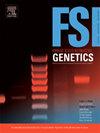评估全基因组和有针对性的法医测序方法来确定亲属关系。
IF 3.1
2区 医学
Q2 GENETICS & HEREDITY
引用次数: 0
摘要
亲属关系确定是法医遗传学中的一项有价值的工具,其应用包括家庭搜索,灾难受害者鉴定和调查遗传谱系。少量常染色体短串联重复序列(STRs)的常规分型只能确定一级亲属。大规模平行测序(MPS)可以访问更多的str并分辨长度相同但序列不同的等位基因(等等位基因),这可能会增加亲缘关系估计的能力,特别是当与额外的单核苷酸多态性(SNP)位点相结合时,如在ForenSeq DNA签名准备试剂盒中。在ForenSeq Kintelligence试剂盒中可获得约10,000个SNP的MPS测序,有望检测到更遥远的亲属,而携带数十万个标记的SNP芯片进一步提高了分辨率。在这里,我们通过一组谱系和模拟来评估这些不同的分辨率。正如预期的那样,影响亲属关系估计精度的关键因素是分析的标记数量,基于mps的STRs分析提高了分辨率,使用全套ForenSeq DNA Signature Prep试剂盒标记可以检测第三度亲属。由于SNP芯片包括非常染色体(X染色体和y染色体以及线粒体[mtDNA])标记,我们询问这些标记在谱系中的表现如何,交叉参考Y-STR序列数据。我们强调在日益复杂的Y和mtDNA系统发育中理解单倍群分辨率的重要性,以避免错误的排除。X-SNPs的结合允许在家族内追踪x染色体片段。这些不同的方法可以增加亲属关系估计的价值,但有些方法需要更简单的生物信息学接口,以便在实践中更广泛地使用它们,并且还需要访问适当的等位基因频率数据,以避免与祖先错误描述相关的问题。本文章由计算机程序翻译,如有差异,请以英文原文为准。
Evaluating genome-wide and targeted forensic sequencing approaches to kinship determination
Kinship determination is a valuable tool in forensic genetics, with applications including familial searching, disaster victim identification, and investigative genetic genealogy. Conventional typing of small numbers of autosomal short tandem repeats (STRs) confidently identifies only first-degree relatives. Massively parallel sequencing (MPS) can access more STRs and resolve alleles identical by length but differing in sequence (isoalleles), which may increase the power of kinship estimation, particularly when combined with additional sequenced single nucleotide polymorphism (SNP) loci, as in the ForenSeq DNA Signature Prep kit. MPS sequencing of ∼10,000 SNPs is available in the ForenSeq Kintelligence kit, promising detection of more distant kin, while SNP chips carrying hundreds of thousands of markers increase resolution still further. Here we evaluate these different resolutions in a set of pedigrees, and via simulations. As expected, the key factor influencing the precision of kinship estimation is the number of markers analysed and MPS-based analysis of STRs increases resolution, with the full set of ForenSeq DNA Signature Prep kit markers allowing detection of third-degree relatives. Since SNP chips include non-autosomal (X- and Y-chromosomal, and mitochondrial [mtDNA]) markers, we ask how these perform within the pedigrees, cross-referencing to Y-STR sequence data. We highlight the importance of understanding haplogroup resolutions in the increasingly complex Y and mtDNA phylogenies, to avoid false exclusions. Incorporation of X-SNPs allows tracing of X-chromosome segments within families. These different approaches can add value to kinship estimation, but some require simpler bioinformatic interfaces to make them more widely accessible in practice, and also access to appropriate allele frequency data to avoid problems associated with ancestry mis-specification.
求助全文
通过发布文献求助,成功后即可免费获取论文全文。
去求助
来源期刊
CiteScore
7.50
自引率
32.30%
发文量
132
审稿时长
11.3 weeks
期刊介绍:
Forensic Science International: Genetics is the premier journal in the field of Forensic Genetics. This branch of Forensic Science can be defined as the application of genetics to human and non-human material (in the sense of a science with the purpose of studying inherited characteristics for the analysis of inter- and intra-specific variations in populations) for the resolution of legal conflicts.
The scope of the journal includes:
Forensic applications of human polymorphism.
Testing of paternity and other family relationships, immigration cases, typing of biological stains and tissues from criminal casework, identification of human remains by DNA testing methodologies.
Description of human polymorphisms of forensic interest, with special interest in DNA polymorphisms.
Autosomal DNA polymorphisms, mini- and microsatellites (or short tandem repeats, STRs), single nucleotide polymorphisms (SNPs), X and Y chromosome polymorphisms, mtDNA polymorphisms, and any other type of DNA variation with potential forensic applications.
Non-human DNA polymorphisms for crime scene investigation.
Population genetics of human polymorphisms of forensic interest.
Population data, especially from DNA polymorphisms of interest for the solution of forensic problems.
DNA typing methodologies and strategies.
Biostatistical methods in forensic genetics.
Evaluation of DNA evidence in forensic problems (such as paternity or immigration cases, criminal casework, identification), classical and new statistical approaches.
Standards in forensic genetics.
Recommendations of regulatory bodies concerning methods, markers, interpretation or strategies or proposals for procedural or technical standards.
Quality control.
Quality control and quality assurance strategies, proficiency testing for DNA typing methodologies.
Criminal DNA databases.
Technical, legal and statistical issues.
General ethical and legal issues related to forensic genetics.

 求助内容:
求助内容: 应助结果提醒方式:
应助结果提醒方式:


